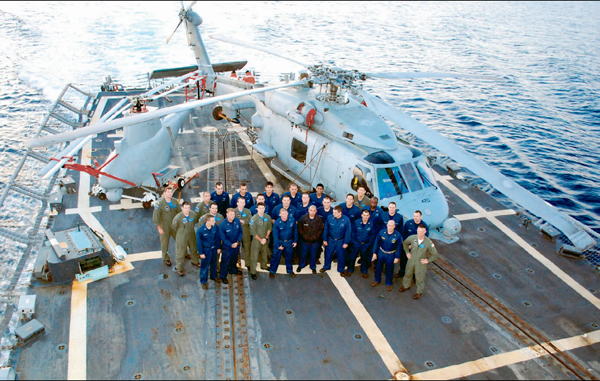
Helicopter Antisubmarine Squadron Light 42 Detachment Two on the Guided-Missile Frigate USS Halyburton
The Navy’s MQ-8B Fire Scout vertical-takeoff/ vertical-landing unmanned aerial vehicle (VTUAV) has deployed for the first time in the Southwest Asia region, where the helicopter is being tested in the challenging environments of the Arabian Sea and Afghanistan.
A detachment with two MQ-8Bs is deployed aboard the Perry-class guided-missile frigate USS Halyburton for counter-piracy operations in the Arabian Sea off the Horn of Africa, while a land-based detachment of three MQ-8Bs is deployed in support of Army and coalition forces in northern Afghanistan. Halyburton deployed with two MQ-8Bs and one SH- 60B Seahawk helicopter instead of the normal two SH- 60Bs. The aircraft are manned by a detachment from Helicopter Antisubmarine Squadron Light 42 (HSL-42).
Last year, another detachment of the same squadron onboard the Perry-class frigate USS McInerney took the Fire Scout on a deployment to the Caribbean and Eastern Pacific.
“Fire Scout provides us with an additional asset to conduct either [surface search coordination] or ISR [intelligence, surveillance and reconnaissance] missions, Cmdr. John Schmidt, commanding officer of Halyburton, said in an e-mail. “The BRITE STAR II electro-optical/ infrared camera installed on Fire Scout provides a much sharper image than the forward-looking infrared installed on the SH-60B, and Fire Scout has a slightly longer flight duration/on-station time. The [Fire Scout] aircraft also is smaller, quieter and harder to detect than the SH-60B, and since no aircrew is at risk this provides additional options for employment.
“Our deployment has been primarily focused on counterpiracy, and we’ve used Fire Scout in that role,” Schmidt said. “The ability to see what is going on, without being detected, and while keeping the ship over the horizon and out of sight, has been a plus in our operations. The imagery has also been of great value to other ships and commanders off ship in evaluating the actual situation, allowing them to make appropriate operational and tactical decisions.
“In one case, Fire Scout aided us in providing humanitarian assistance to a stranded Yemeni fishing dhow,” he said. “Although the ship was some distance away, the Fire Scout imagery of the dhow dead in the water and the crew showing obvious signals of distress, once they had sighted the aircraft, made it clear what was happening and enabled the ship to respond appropriately.”
Deployed with Halyburton are hand-held remote viewing terminals that can receive video downloaded in real time from the Fire Scout. “The idea was for the boarding team to have video as they were going aboard the ship,” Dunigan said. “The Fire Scout would stay up high and the team, as they approached the ship, would have 100 percent situational awareness of what’s going on [on that ship].
As of May 23, the Fire Scouts on Halyburton had accrued 100 flights during 55 days of flying, for a total of 349.5 flight hours and an average of 6.4 hours per day, Dunigan said. The operational availability of the Fire Scouts was greater than 95 percent. Dunigan praised the 4.0 maintenance man-hours per flight hour figure as outstanding.
Three MQ-8Bs and two ground-control stations were flown to Afghanistan in April and are scheduled to remain there for a year. The Fire Scouts are Navy-owned but are operated by Northrop Grumman contract personnel, who also maintain the Fire Scout systems in-country. The first flight in theatre was made on May 2 and the detachment was declared operational on May 21. As of May 31, the detachment had accumulated 66 sorties and 193.1 flight hours.
As of late May, 26 MQ-8Bs — six developmental versions and 20 production aircraft — had been authorized and funded by Congress and 15 had been delivered. The Navy plans to procure a total of 168 MQ-8Bs. The average procurement unit cost is $10.1 million and the total estimated programme value, including development, procurement, operations and sustainment costs, from 2000-2028, is $5.6 billion, according to Dunigan.
The operational evaluation of the Fire Scout is scheduled on land for this summer, followed by a shipboard period planned for October and November. Dunigan said the ship for the evaluation has not yet been selected. The Fire Scout will again deploy in January on a ship.
Source: Seapower
